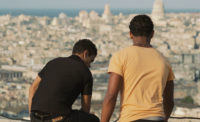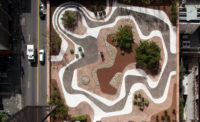“Cool” is one of those words that has been so overused to be almost meaningless. So when a television show comes along called Cool Spaces!—with an exclamation point no less!—you’d be excused for any apprehension. But the program, a four-part series that focuses on the best new architecture in the U.S. and premieres on PBS affiliates across the country early this month, is considerably better than its title.
The goal of the show, says architect/teacher/host Stephen Chung, is to “deconstruct the world of architecture.” To do that, each episode of Cool Spaces! is devoted to a theme and explores three new buildings that fit that theme. The first episode is centered on performance spaces and takes viewers deep inside AT&T Stadium, the home of the Dallas Cowboys in Arlington, Texas, designed by HKS; the Kauffman Center for the Performing Arts in Kansas City, Missouri, designed by Safdie Architects; and Barclays Center in Brooklyn, New York, designed by SHoP. (Future episodes focus on libraries, art spaces, and healing spaces.) Each building gets between 15 and 20 minutes of screen time—the episode itself is 58 minutes—and Chung does his best to hit the high notes at each facility: AT&T’s epic single-span roof structure, the longest in the world, for example, or how SHoP wedged a world-class professional sports facility into a narrow, triangular parcel of land in the middle of downtown Brooklyn.
As an arts and sports lover, it was particularly interesting watching Chung discuss the design, form, and function of these buildings with the architects, acousticians, club owners, and organization leaders, though I confess to shuddering in horror hearing Cowboys owner Jerry Jones call the dearly departed Astrodome “inspirational.” But Chung also takes things off-site, talking with structural engineers and acoustical experts in a lab setting to explain how the forces at work on large pivots hold up AT&T Stadium’s roof and why the Kauffman Center’s performance halls are concrete under their exquisite sound-reflecting wood. These moments are a little too fleeting, but they’re some of the best parts of the show. They take it beyond a simple aesthetic discussion of some “cool spaces” and inject an energizing dose of science into the program.
Chung, too, helps steer the show away from surface glances. He cues up a telestrator when discussing each building to illustrate a key component of the structure, be it the geolocation of the Kauffman Center or how a massive basketball arena was integrated into a bustling urban center. Chung can be a little stiff when it’s just him and a camera, but you forget about that when he’s with the people he interviews. He’s able to draw on his experience as an architect and educator to ask smart questions that elicit meaty answers, and then he helps us navigate the technical terms and shoptalk. In other words, you don’t have to be an architect or design expert to come away with a deeper, functional appreciation of these buildings.
And that’s really what makes Cool Spaces! work. On one hand, the three buildings Chung focuses on here are blockbusters and there’s a certain obviousness to the choices. But on the other, that makes the show’s job easier. If it can present three spaces a lot of people will know, it can get right to the heavy lifting of helping viewers develop a new appreciation for the creativity, ingenuity, and expertise that went into them—as well as the arenas, stadiums, and performing arts theaters in their communities. So, yes, these are, in fact, some cool spaces. But did the title really have to be that literal?
Cool Spaces! premieres on PBS this month. Check out the show’s website for a complete schedule of air dates.



Post a comment to this article
Report Abusive Comment